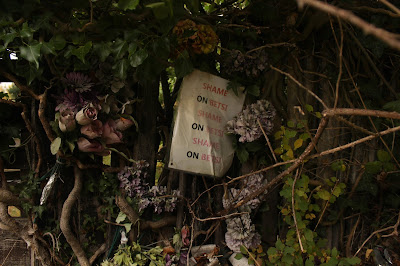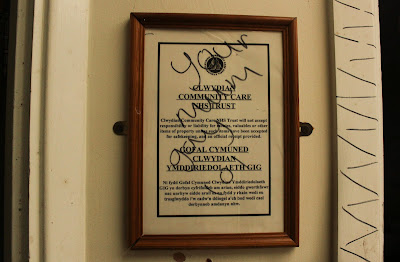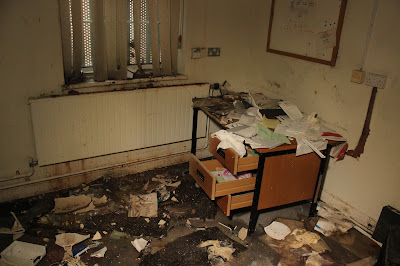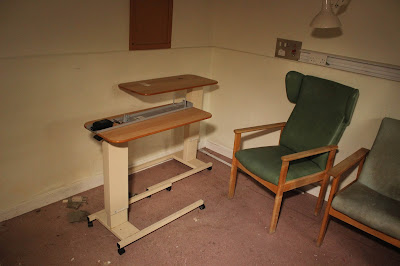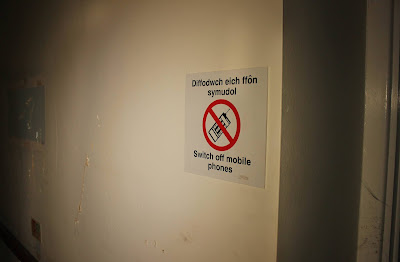(Disclaimer:
Joking aside, I fully understand the risks/dangers involved in these
adventures and do so in the full knowledge of what could happen. I don't
encourage or condone and I accept no responsibility for anyone else
following in my footsteps. Under UK law, trespass without force is a
civil offence. I never break into a
place, I never photograph a place that is currently occupied, I never take any
items and I never cause any damage, as such no criminal offences have
been committed in the making of this blog. I will not disclose location. I leave the building as I find it and
only enter to take photographs for my own pleasure and to document the
building.
Today I'm looking at this cottage hospital in Wales, once an integral part of its local community, now an expert-level jigsaw puzzle. Usually I wait at least six months between going somewhere and posting it online, and in the time it took me to get around to writing about this place, it's been set on fire and demolished. That's pretty shit.
But, as someone who believes in documenting history, I do get a sense of fulfilment whenever I manage to snap a place before it's gone for good. Fifty years from now, nobody will mind that some mild trespass was involved, only that the place was documented in some form, even if it is as in its sad final days. I guess you could call this a post-mortem.
I first learned of this place through the most laziest of means, by doing absolutely nothing while urban explorers chatted to or around me. Occasionally urban explorers will assume that the person they're talking to knows all the same things as them, and will say something along the lines of "Have you been to that [insert thing] in [insert town]?" And on this occasion they were talking about this place, and no, I hadn't even heard of it until that point. Whoopsie.
Given the rumours of the hospitals upcoming demolition, and since it wasn't being smeared all over the internet like some of the trendier locations, I decided to give it a visit.
The building was in pretty bad shape, having been subjected to a wave of vandalism, while efforts to secure it appeared to have been a one-off occasion, not followed up on through subsequent break-ins. Access was simple because the place was wide open. Allegedly numerous people, including members of the council, have told the owners that it's wide open, but nothing's been done.
The owners didn't care. The local yobs didn't care. The only indication that anyone ever cared for this place was the collection of flowers on the fence blocking the driveway. These were left here by the townsfolk mourning the loss of the hospital. It seems that the closure of the hospital was a very unpopular move.
Amongst the flowers are laminated signs reading "Shame on Betsi."
Ah yes, Betsi, evidently the villain of this tale. Not quite as sinister as Thomas Cheadle, the villain of the last blog, or my usual arch nemesis, Gravity, but nevertheless, it's a name so sweet and innocent, it can only belong to a real super villain. In my imagination, I was picturing a bitter old crone working for the council, but alas, in reality this Betsi isn't even a human.
Betsi is the local health board, named after Betsi Cadwalladr, a famous Welsh nurse who I very much doubt had anything to do with the closure of this place, seeing as she died in 1860.
Unlike the health board of the same name, the real Betsi has been listed among the top fifty best Welsh folk of all time, beating Anthony Hopkins, which surprised me, and also Tom Jones, but that's not unusual.
When Betsi (the human, not the health board) was fourteen she got bored of normal life and ran away from home, returning in adulthood only to run away a second time in order to escape marriage. She ultimately ended up traveling the world before becoming a nurse on the frontline of the Crimean wars when she was 65. During this period she clashed with her arch nemesis, none other than Florence Nightingale, who took an instant disliking to Betsi for being working class and Welsh, pretty much forming her bias around a publication from 1847 that made out that Welsh people were all uneducated barbarians. The story doesn't really shine a positive light on Florence, does it? She's basically a Victorian-era equivalent of a Daily Mail reader. Florence did eventually give Betsi the credit she deserved, but only after bullying her to the point that she'd relocated to a different hospital closer to the frontlines, where she made a name for herself battling bureaucracy to make sure people got the supplies that they needed.
It's a little sad that everyone knows who Florence Nightingale is, but I had to look up Betsi Cadwalladr.
It's also a little ironic that someone who fought against bureaucracy to get people the healthcare that they needed is the namesake of a health board who pissed off an entire town by closing their hospital. But I'm sure their successes outweigh their less popular decisions. Let's not hate on Betsy too much.
The street-facing two-floor portion of the hospital appears to be older than the single-story chunk that protrudes from the back of it. Evidently it had a modern extension put in. What's interesting is that this modern extension became the official entrance of the place, facing the carpark at the rear of the building. Presumably the street-facing doorway was the original entrance. The only indication now is this floor mural in the doorway.
However this is the only clue. Otherwise this portion of the building doesn't have an entrancy vibe at all. Maybe it was used by the staff, but definitely not the public. It leads to the interior staircase, but all the signs saying "Way Out" point in the opposite direction, towards the newer entrance.
If this was the original entrance, I would love to see old pictures. It's probably changed a lot since then, the extension no doubt bringing about a refurb. Presumably there would have been a reception desk, but it seems awfully cramped.
Now, the reception desk is at the other end of the building, by the newer entrance, and it's perhaps the only thing there that's still in one piece.
Prior to this adventure, I'd actually never come across the term "cottage hospital" before. It's mildly archaic and semi-obsolete. Obviously larger towns have gigantic sprawling hospitals, but given the size of this place, it's perhaps more comparable to a smalltown GP. It meets all the needs of a regular hospital though, but scaled down for a small rural community. These were apparently all the rage in the 1800s, back when transport was less accessible and folks living in rural communities couldn't make the trip to the larger towns.
Most of them were converted from residential dwellings, and they had the advantage of familiarity, because the doctors and nurses would all know the locals that they were treating.
While these sort of places popped up a lot during the Victorian era, this one was late to the party. Unlike those that were converted from established dwellings, this one was purpose built for hospital use in 1918. It was donated to the community by the huge textile company called Courtaulds, presumably to win over the locals. While they were a huge company, their prominence in this local area was relatively new, gained purely by taking over a German-staffed textile factory that suddenly fell on hard times when all of their staff were interned during World War One.
The cottage hospital finally opened its doors to the public in 1920, although the town didn't get electricity until 1926 so those first few years must have been a real bitch.
The inside was pretty trashed, but as always in such locations, I find it interesting to see exactly what has survived the carnage. In this case, the photocopier guidelines still hang on the walls. What's up with that? Are the local yobs passionate about photocopying or something?
In its glory days, this cottage hospital had fourteen beds and a minor injuries unit that was open seven days a week and used by about six patients a day on average.
Unfortunately that dastardly Betsi Codswallop decided that the facilities were not suitable for the size of the population, and the sensible course of action was to close it entirely, forcing the population to travel five additional miles to the next one.
The townsfolk were pretty furious and fought fiercely to get Betsi to reconsider its course of action. Thousands of people took to the streets in protest and signed angry petitions. But in spite of their efforts, Betsi would not be swayed.
The hospital closed its doors for good in 2013. From then on, all people coming in used the windows.
Behind the reception desk, the spaces for folders still have their labels, but thankfully the paperwork is long gone. It should be an obvious expectation really, but you'd be surprised.
There's some kind of swab thing on the reception desk. Not sure what that's for, or how it's survived the wave of destruction that seems to have hit this place. In these crazy times we live in, it might make people think of the 'rona tests, but that's not what this is. I'm still in no rush to touch it though.
I did try to find old photos of this place from back when it was still in use. There are plenty of the outside, but barely any of the inside. Eventually I managed to find one of this rather smashed up corner here, depicting it as a small waiting area, with seats and a leaflet stand.
(Photo credit: Dan Jones)
What a transformation! Behind this window is this random little courtyard, completely surrounded by the building and seemingly pointless. There's a door leading out to it, and once outside there's maybe enough room to do some star jumps.
What's odd is that the door has a sign saying that no unauthorised people are allowed out there, into this tiny patch of outdoors thats completely supervisable from the reception area via a window. There are windows all around, so I guess it could be argued that someone out here could see into some of the wards, but anyone looking out through the waiting area window could also look into the wards. That's why they have blinds.
It just seems like a completely pointless patch of land to ban access to. There's no reason to actually want to go out there either, really. The space is both pointless in its existence and in its lack of permitted accessibility.
This room just off from the reception is the defibrillator station and also the minor injuries unit. Ironically it now looks like you're more likely to sustain a minor injury here.
The place has been completely wrecked. The cupboards have been opened, and whatever was in there has been strewn all around.
This might not be immediately recognisable to people outside of healthcare, but it's a clinical waste bin lying on its front with the lid open. When it's upright, a yellow bag would be contained in the black frame.
There's still mop buckets here. In places like this they're colour coded. Red are for bathrooms and toilets, and yellow is for clinical waste, which might include medication, blood, and stuff that might be infectuous.
Moving back out to the reception area, there's another area that seemed a bit odd, and that was the "League of Friends Tea Bar."
Why did I find it odd? Well it's basically just a cupboard.
I presume the patients in the waiting area just helped themselves and paid at the reception desk. If someone was actually stationed in this cupboard selling people snacks and tea, that would be a little bit absurd.
The older portion of the hospital is definitely my favourite, and there's still a few old beds dotted around. I'm not sure who was responsible for clearing this place out after it closed, but if it closed because its facilities weren't sufficient for the size of the population, surely that would neccessitate the retaining of as many facilities as possible when the services moved elsewhere, and not letting something vital to a hospital, like a bed, go to waste. Oh Betsi...
I have no idea what this area was for, but I'm going to take a guess and say that it was a cafeteria area. This is purely because of its proximity to the kitchen, and because I don't know what else a hospital would have in such a spacious room that clearly wasn't a ward.
Edit- I've since been told that this was originally the matrons sitting room and office, but towards the end of the hospitals usage it was a hospice room nicknamed "The Sunshine Room" because the windows made it so bright and peaceful in here. In the later end of the 20th Century more people probably died in here than in any part of the building. It doesn't have a dark vibe though.
Separating the Sunshine Room and the kitchen is this hallway. It's got some fantastic natural decay, with the ceiling collapsing, letting nature in.
Here's the kitchen. As is often the case in kitchens in derelict places, this one had a particularly nasty odour. Unlike most kitchens, there's an office desk where the cooking equipment should be.
Moving on from this abysmal kitchen, it was time to check out the actual wards...
The wards are by far the eeriest part of the building. Hospitals have a strange vibe even when they're still in use, and this one being trashed hasn't altered that at all. If anything its age adds to the vibe. These rooms have treated their community for almost a hundred years. Pretty much everyone in the town knows someone who has been treated, worked, or died here. There's probably been a lot of sadness.
And now the best part of any abandoned building, the toilets.
Still in better condition than the toilets in some pubs and clubs.
But if you want something really grim, check out this curtain.
That's some pretty horrific mold.
Here we have the consulting suite.
There's some graffiti here, but it's not creative or artistic. It's just the scrawlings of someone who had their life goals stripped away when the Jeremy Kyle Show was canceled.
This whiteboard still has some of the original hospital writing on it, somehow surviving the horde of kids...
Although every time I point the finger at the younger generation, I feel a little remorseful and unfair. The truth is, I've been in this game long enough to have seen similar behaviour from fifty-year-old unemployed men too. Generalising based on age is easy, but it's not always right.
Here we have the consulting room, still furnished but trashed, mouldy and suffering from an unpleasant combination of carpeted floor and leaking ceiling.
Somesones scribbled Amug Jones on the board. Poor Amug. Imagine your parents naming you after a drinking utensil. What, did the babys father and the mothers work colleague both simultaneously ask "What shall we name it?" and "What shall we get Sandra for a secret Santa present?"
Here's a couple of notices, one in Welsh and the other in English, pointing out that some of the services were moving to other facilities, dated 2013. This is pretty sad. These documents are heralding the hospitals eventual closure.
I'm actually quite surprised at how much stuff has been left behind. This place must have been left almost exactly as it was when it was open, with minimal effort to move anything, except perhaps legal documents. If I'd explored it around 2014 or 2015, it would probably have been pristine. Based on this, you'd think Betsi had plans for the building, and yet their actions, or lack of, would indicate otherwise.
Still, if I'd blogged about a pristine hospital in 2015, people would swear it was going to be reopened and that I'd snuck in to an active site or something. At least this way there's no denying that this place has been empty for some time.
There's still a bin bag in the clinical waste bin... that seems pretty ominous. It's also baffling that it's managed to survive the wave of vandalism.
Here's the laundry room...
There's still a washing machine here! And most disturbingly it looks like there's still stuff inside it.
There's another set of toilets here that are somehow even worse than the last bunch.
And then amongst all that chaos we have this oddly clean office. What, did the local yobs miss this room?
Wait, false alarm. They spotted the radiator. The yobs must just really have a fondness for hospital office armchairs.
That's it for the ground floor, but the majority of the vandalism seems to have taken place upstairs. The stairs in this building are at the "back" of the building, if you're considering the reception to be the front. The original main entrance to the building actually leads straight to the stairs. I'm not sure what purpose the upstairs had in the 1920s when the hospital was built, but in the modern day, it was probably just a staff area.
Well it's seen better days. This definitely seems to be the focal point of the local yobs. The graffiti gets a teeeeeny bit better though.
I mean, it's not good. But it's better than what we've already seen.
This room is labeled the "chill room," and it's got a warning urging visitors to either not trash it, or fuck off.
Oh look, it's not trashed in the slightest, said nobody ever. This weird contraption bed chair thing indicates that they did see some patients upstairs though, meaning I was wrong about my earlier assumption, unless someone dragged it up here. However I think it was mostly just offices up here.
This definitely seems to be the hang out spot for the locals too, given the collection of seats and the graffiti on the walls.
There's a list of names here, written above a drawing of Kate Hopkins going down on a man with a rather perky bottom. The names... well I hope they aren't entirely real. If Callums middle name is "Pussy" then it's no wonder he spends his time drawing stuff like this inside derelict hospitals. I am quite a fan of "Benjaminge" though, but that's because I like wordplay. Anyway, as well as the names of kids, we also have anal beads, pissy pants and nips.
It's like whoever wrote it was trying to remember the names of his friends, realised he only had three, and instead decided to list the things he wanted to buy from Wish.
I see my arrival was (meanly) foretold...
I guess they also foretold my noticing of the graffiti guys perky bottom. Goddammit.
The wall over there is pretty fucked. The walls that aren't fucked seem to be the canvas for someones ramblings. I like the fireplaces though.
One final part remains and that's the attic, accessible via this narrow stairway to the left of the main stairway.
This is definitely the staff area. Now it's home to a solitary armchair and a hole in the ceiling.
There's this pretty ominous crawlspace too with a sad/dead face above it.
Aaaand I guess given that this place has ended up this way due to mismanagement from the local health board, it's only fitting to end with a shot of a giant graffiti cock.
But alas, this cock, the wall it's on, the rest of the hospital, and everything in it, has since been destroyed. Following the arson attack, the usual conclusions were drawn. Some of the locals suspected that it was an insurance job carried out by Betsi, or on their behalf. Others suspect local kids, their evidence coming from another fire at a local park only a couple of nights prior.
I guess you could call this evolution. Benjaminge and Callum have discovered the power of mans red flower so they can be like you.
However, those suspicious of Betsi will tell you that developers had their eye on this place for months before it closed. We'll probably never know the truth, but regardless of who caused the fire, it can be assumed that the folk at Betsi allowed it to happen indirectly, even if they didn't have a hand in it. At numerous points over the last few years, locals had told them that the premises were open and being trashed by kids. Even a local councillor told them, but they seemed content to not secure the site, and leave it to the yobs.
After the arson attack, the rest of the building was demolished. The saving grace is that there will be a new care home built here in the years to come, and there's also talk of some kind of remembrance garden to honour the former hospital too. In addition to that, some of the hospitals tile art has been saved and is on display in another nearby medical center. I guess that's about as much of a happy ending as we can get from a place like this, given the circumstances. At least I managed to document it before it was gone forever.
That's all I got for the cottage hospital. My next two blogs will be dilapidated churches, one of which I had the joy of accidentally walking in on a couple of homeless people having sex. At least I think they were homeless. I didn't stop to ask.
Anyway in the meantime, follow me on my social media. I'm mostly on Instagram, but I also use Vero, Twitter and Reddit. Oh, and that hellscape that is Facebook. Follow my page there too.
Thanks for reading!





